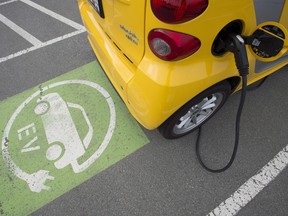Canada has committed tens of billions of dollars to revitalizing its battery sector. History suggests it needs a strategy to make sure that bet pays off
Get the latest from Gabriel Friedman straight to your inbox Sign Up
Published Aug 12, 2024 ┬атАв┬а Last updated 1┬аhour ago ┬атАв┬а 4 minute read
You can save this article by registering for free here. Or sign-in if you have an account.
 A electric car getting charged at a parking lot in Tsawwassen, near Vancouver, B.C. Photo by Jonathan Hayward/The Canadian Press filesArticle content
A electric car getting charged at a parking lot in Tsawwassen, near Vancouver, B.C. Photo by Jonathan Hayward/The Canadian Press filesArticle content
The federal government, having committed tens of billions of dollars to the buildout of a Canadian electric vehicle battery supply chain, still has work to do to ensure the nascent industry not only survives the ups and downs of market demand, but thrives, according to a new report.
The report, released Monday by Accelerate, an industrial alliance of key battery sector players, lays out a strategy тАЬto establish Canada as a global leader in battery technology by 2035,тАЭ and recommends removing regulatory barriers and creating new funding mechanisms to raise another $3 billion in public and private investments.
Advertisement 2
This advertisement has not loaded yet, but your article continues below.
THIS CONTENT IS RESERVED FOR SUBSCRIBERS ONLY
Subscribe now to read the latest news in your city and across Canada.
Exclusive articles from Barbara Shecter, Joe O’Connor, Gabriel Friedman, and others.Daily content from Financial Times, the world’s leading global business publication.Unlimited online access to read articles from Financial Post, National Post and 15 news sites across Canada with one account.National Post ePaper, an electronic replica of the print edition to view on any device, share and comment on.Daily puzzles, including the New York Times Crossword.
SUBSCRIBE TO UNLOCK MORE ARTICLES
Subscribe now to read the latest news in your city and across Canada.
Exclusive articles from Barbara Shecter, Joe O’Connor, Gabriel Friedman and others.Daily content from Financial Times, the world’s leading global business publication.Unlimited online access to read articles from Financial Post, National Post and 15 news sites across Canada with one account.National Post ePaper, an electronic replica of the print edition to view on any device, share and comment on.Daily puzzles, including the New York Times Crossword.
REGISTER / SIGN IN TO UNLOCK MORE ARTICLES
Create an account or sign in to continue with your reading experience.
Access articles from across Canada with one account.Share your thoughts and join the conversation in the comments.Enjoy additional articles per month.Get email updates from your favourite authors.Sign In or Create an Account
or
Article content
тАЬCanada has made a huge bet on batteries with strategic investments in up to 195 GWh of battery production across three facilities,тАЭ the report commissioned by Natural Resources CanadaтАЩs Energy Innovation Fund said. тАЬThe task now is to maximize the value of these factories by building the production networks around them into an innovative ecosystem that increases efficiency and advances the core technology.тАЭ
Moe Kabbara, one of the three authors of the report and an advisor to Accelerate, said the genesis of the report was that Canada has a rich history of battery innovation, but the sector did not receive support at critical moments.
For example, in the 1980s, Moli Energy was a Vancouver-based company and among the first in the world to manufacture lithium-ion batteries. The report estimates that Moli received $120 million in government support, but it then fell badly out of favour when one of its battery cells caught fire.
Most of our winners were lost
Moe Kabbara
According to the history laid out in the report, after the conflagration, British Columbia called in a loan, which forced the sale of Moli to a Japanese consortium for $5 million, which the authors characterized as a bargain-basement price given their estimate that the company had $58 million in assets.
Advertisement 3
This advertisement has not loaded yet, but your article continues below.
Article content
тАЬWe havenтАЩt been really able to cash that out in terms of being able to say, тАШHey, hereтАЩs a leading Canadian battery company,тАЭ Kabbara said. тАЬMost of our winners were lost.тАЭ
To ensure that Canada can compete in batteries, which are the subject of intense global competition, the report makes a number of specific and general recommendations, including removing regulatory barriers and creating new funding mechanisms.
It said Canada must focus on an industrial strategy that supports the scale-up of battery production and captures the value of intellectual property produced within the sector.
Bentley Allan, also an author of the report and an adviser to Accelerate, said that part of the report is about setting targets for Canada, so thereтАЩs some accountability and a way to measure success. To do this, they studied the battery sector in Korea and the critical minerals sector in Australia to look at what other jurisdictions have done.
Much of the report is focused on innovation. It lays down energy density performance targets, dates by which battery prices should drop and when battery chemistries should change.
Advertisement 4
This advertisement has not loaded yet, but your article continues below.
Article content
тАЬThose targets are important,тАЭ Allan said. тАЬWe need to make sure we know exactly what the technological targets are that weтАЩre trying to achieve here.тАЭ
We havenтАЩt been really able to cash that out in terms of being able to say, ‘Hey, hereтАЩs a leading Canadian battery company
Moe Kabbara
By 2035, the report suggests Canada should seek to increase the number of Canadian-owned firms in the battery sector by tenfold, which it suggests should contribute about 20 per cent of the battery value chain in North America. It also sets a benchmark for these companies to secure 1,000 patents by that time, which the government should support by enhancing the patent processing system to make it faster and more flexible so that the technologies can be shared among domestic companies.
Some recommendations are practical. It calls for the creation of a central coordinating body that can unify government, academia and industry to implement its roadmap and a government тАЬproblem-solving team.тАЭ
Other recommendations are highly specific, such as attracting $3 billion in public and private investments in the battery supply chain: $500 million for advanced manufacturing, $1 billion for emerging technologies and $1.5 billion for demonstrations and pre-commercialization projects.
Advertisement 5
This advertisement has not loaded yet, but your article continues below.
Article content
тАЬThe idea is that we want Canadian companies to play in the global supply chain and play in the global market,тАЭ Kabbara said.
He said that given CanadaтАЩs proximity to the United States, there is a history and a real risk of domestic companies being purchased by larger U.S. companies, an outcome that would deprive the Canadian economy of some of the benefits of building out a battery supply chain.
Kabbara said he doesnтАЩt think Canada can ban such acquisitions, but it can support domestic companies, especially startups, through market ups and downs to make sure those companies donтАЩt end up being sold for bargain prices if they hit a stumbling block.
To that end, the report recommends тАЬa dedicated Battery Innovation Venture FundтАЭ to provide early stage capital. It also recommends expanding the Office of Energy Research and DevelopmentтАЩs funding program so that it can provide тАЬlarger grants for growth-stage companies.тАЭ
A third recommendation is that Canada implement research and development minimums for publicly supported companies to ensure they are contributing to the countryтАЩs innovation ecosystem.
Advertisement 6
This advertisement has not loaded yet, but your article continues below.
Article content
Recommended from Editorial

Unifor calls for 100% tariffs on Chinese EVs

Canada at tricky fork in road as China EV tariff decision looms
тАЬThese are problems that everybody has been talking about for two decades,тАЭ Allan said, тАЬand we tried to say very clearly how an industrial policy for batteries could solve them, or at least what the government could do in the short term to address this. If weтАЩre going to build something bigger, then we need a broader plan than just plunking down battery plants.тАЭ
тАв Email: [email protected]
Bookmark our website and support our journalism: DonтАЩt miss the business news you need to know тАФ add financialpost.com to your bookmarks and sign up for our newsletters here.
Article content
Share this article in your social network
Source link : http://www.bing.com/news/apiclick.aspx?ref=FexRss&aid=&tid=66ba2b794de848f6a18d9519c8b01f21&url=https%3A%2F%2Ffinancialpost.com%2Fcommodities%2Fenergy%2Felectric-vehicles%2Fcanada-strategy-ev-battery-bets-pay-off&c=3584467221425574611&mkt=en-us
Author :
Publish date : 2024-08-12 03:26:00
Copyright for syndicated content belongs to the linked Source.












